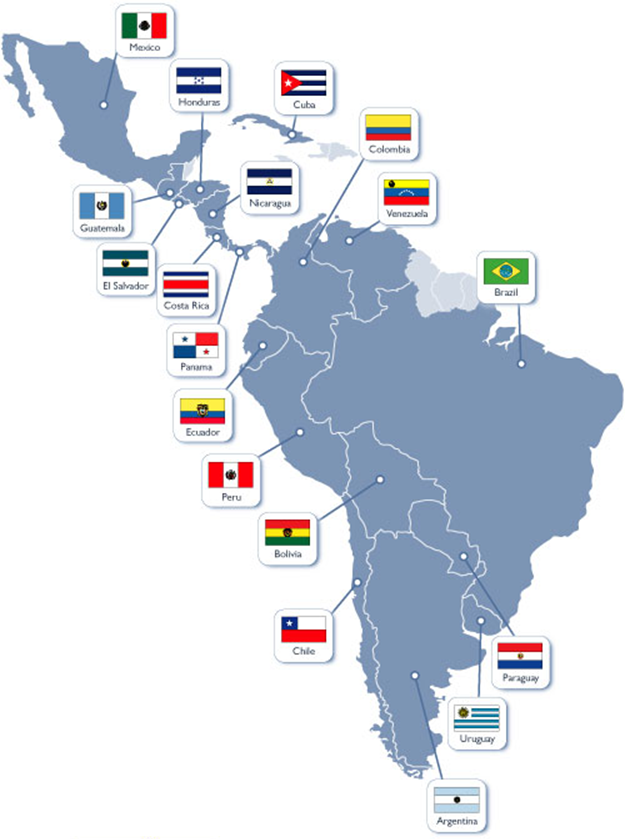Latin American scientific network on DLDD
The development of an effective DLDD Information System for Latin America requires that all countries and organisations in the region work together for the survey, collection and harmonisation of available data, information and tools, in order to create a common system that is integrated and interoperable.At the regional level a basic assumption is that one party is dependent on the resources and competencies controlled by another, and that there are gains if the resources and competencies can be pooled. A scientific network for Latin America is being developed to capture the attention and the support of dedicated national and supranational institutions for unsustainable DLDD problems in the region.

Participating Latin American countries
The Latin American scientific network on DLDD is made up of representatives from all countries participating in the EUROCLIMA Programme. The group of experts in the network is working together to improve the assessment, monitoring and mitigation of drought and the problem of land degradation and their impacts on human activities from regional to national scales in Latin America. They facilitate the sharing of information, experiences and best practices through global, regional, and national partnerships.
| Institution | Country | Institution | Country |
|---|---|---|---|
Centro de Relevamiento y Evaluación de Recursos Agrícolas y Naturales (CREAN) |
Argentina |
Instituto Costarricense de Electricidad (ICE) |
Costa Rica |
Instituto Nacional de Tecnología Agropecuaria (INTA) |
Argentina |
Instituto de Meteorología de Cuba (INSMET) |
Cuba |
Instituto Argentino de Investigaciones de las Zonas Áridas (IADIZA) |
Argentina |
Centro Internacional para la Investigación del Fenómeno del Niño (CIIFEN) |
Ecuador |
Laboratorio de Extremos Climáticos en Sudamérica |
Argentina |
Centro de Información Climatológica y Agrometeorológica, Servicio Nacional de Estudios Territoriales (SNET) |
El Salvador |
Consejo Nacional de Investigaciones Científicas y Técnicas (CONICET) |
Argentina |
Comité Nacional PHI Guatemala, Instituto Nacional de Sismología, Vulcanología, Meteorología e Hidrología (INSIVUMEH) |
Guatemala |
Universidad Nacional de Río Cuarto |
Argentina |
Secretaría de Recursos Naturales y Ambiente (SERNA) |
Honduras |
Laboratório de Análise e Processamento de Imagens de Satélites (LAPIS) |
Brazil |
SAGARPA-INEGI-CONAFOR-COLPOS |
México |
Ministerio del Medio Ambiente (MMA) de Brasil |
Brazil |
Centro del Agua para América Latina y el Caribe del Tecnológico de Monterrey |
México |
Universidad Mayor de San Andrés (UMSA) |
Bolivia |
Instituto Nicaragüense De Estudios Territoriales (INETER) |
Nicaragua |
Centro del Agua para Zonas Áridas y Semiáridas de América Latina y El Caribe (CAZALAC) |
Chile |
Autoridad Nacional del Ambiente (ANAM) |
Panamá |
Comisión Económica para América Latina y el Caribe (CEPAL), Naciones Unidas (UN) |
Chile |
Laboratorio de Teledetección (LABTEL) |
Peru |
Organización de las Naciones Unidas para la Agricultura y la Alimentación (FAO, Chile) |
Chile |
Ministerio de Ambiente |
Peru |
Corporación Nacional Forestal (CONAF) |
Chile |
Instituto Nacional de Investigación Agropecuaria (INIA) |
Uruguay |
Instituto de Hidrología, Meteorologia y Estudios Ambientales (IDEAM) |
Colombia |
Universidad Nacional Experimental de los Llanos Occidentales "Ezequiel Zamora" (UNELLEZ) |
Venezuela |




